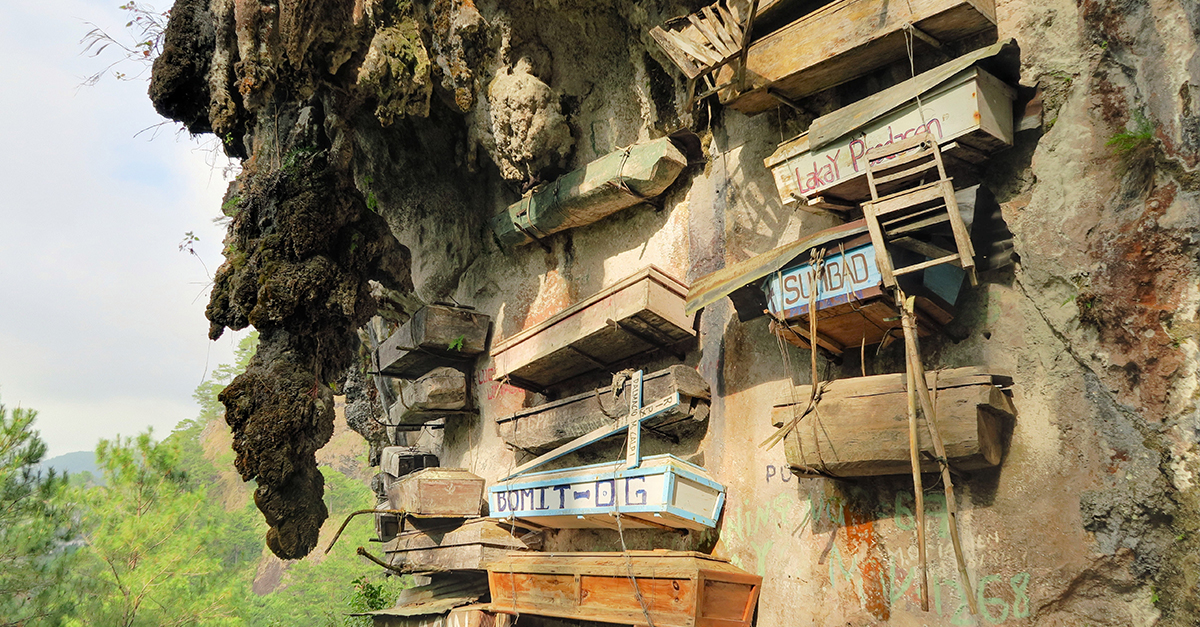An Unlikely Tourist Destination
In the Philippines' mountain province, there is a town called Sagada, which has become a tourist site for a truly macabre, yet fascinating, reason: hanging coffins.

They Are Hundreds Of Years Old
These hanging coffins are a funerary practice of the Kankanaey people. The precise age of these coffins is a bit of a mystery as archaeologists haven't properly investigated them. However, they are likely hundreds of years old.
The Practice Is Fading Out
Today, the funerary tradition of hanging coffins is rarely used—and is gradually dying out. Instead, Christian burials are far more common.
 xavier pou gonzalez, Shutterstock
xavier pou gonzalez, Shutterstock
It Isn't Easy To Hang A Coffin
Practically speaking, the process of hanging a coffin is far more arduous and risky than a Christian burial. Sometimes, even scaffolding has to be built to securely place a coffin, with vines used to maneuver it into place.
 Zuzana Gabrielova, Shutterstock
Zuzana Gabrielova, Shutterstock
The Seem Precarious
These burial cliffs are certainly a sight to behold. The coffins seem to project precariously out of the rock face and are usually covered by natural overhangs.
 xavier pou gonzalez, Shutterstock
xavier pou gonzalez, Shutterstock
It's A Balancing Act
Sometimes wooden beams are fitted into holes in the cliff to help keep the coffins in place, or they sit on rock shelves.
 Alyona Naive Angel, Shutterstock
Alyona Naive Angel, Shutterstock
You Can't See Most Of Them
Many of the places where you can witness these hanging coffins are not accessible to the public as they are too hard to get to. However, one place has become a center for dark tourism.
 Christian Nuebling, Shutterstock
Christian Nuebling, Shutterstock
Echo Valley
Unlike other remote coffin hanging sites, the cliff in Echo Valley can be accessed by tourists—and has become a popular attraction in Luzon. But this isn't necessarily a good thing.
 Saknarong Tayaset, Shutterstock
Saknarong Tayaset, Shutterstock
A Center For Dark Tourism
Due to the sheer number of people, a fence had to be built to protect the site. Obviously, tourists were eager to get close to the hanging coffins. Some would even take out their phones and snap selfies.
The Locals Weren't Happy
What these tourists may not have realized was that their enthusiastic interactions with the coffins were disrespectful to the locals, whose families were buried on the cliffs.
 John Raymond Tibay, Shutterstock
John Raymond Tibay, Shutterstock
They Are Small For A Reason
The coffins themselves are quite small—and for good reason. Instead of the body being laid flat and horizontal, the bodies are curled into a fetal position before being placed in the coffin.
 Christian Nuebling, Shutterstock
Christian Nuebling, Shutterstock
It Comes Full Circle
The decision to bury the bodies in the fetal position is rooted in the belief that human should finish their lives in the same way they began their lives. In fact, this is a prevalent traditions amongst many of the Philippines' pre-colonial cultures.
 xavier pou gonzalez, Shutterstock
xavier pou gonzalez, Shutterstock
They Reflect Social Status
The Kankanaey only use this burial practice of hanging coffins for select people in the community: anyone who was a respected and upstanding leader.
 Manuel Abinuman Jr, Shutterstock
Manuel Abinuman Jr, Shutterstock
Only Leaders Allowed
To have the honor of being buried in a hanging coffin, one had to have led a sage life, done good deeds, and taken charge of important rituals. Even the location of the coffin is a clue as to what the person's social status was.
Height Is Important
The higher the coffin is placed on the cliff, the higher the person's social status was during their lifetime.
They Are Mostly Men
Those who have found their final resting place in a hanging coffin were most likely key figures of the council of male elders—the amam-a.
Buried In Caves
Though the Kananaey do use hanging coffins, they are more likely to use a different burial practice: placing the coffins in crevices or limestone caves.
 xavier pou gonzalez, Shutterstock
xavier pou gonzalez, Shutterstock
Showing Respect
No matter which funerary practice they choose, the Kankaney will make sure to do a particular ritual before the internment. This begs the question: Why do they choose to bury their dead on cliffs or within caves?
 Jungarcia888, Wikimedia Commons
Jungarcia888, Wikimedia Commons
The Spirits Wander Freely
By laying their loved ones to rest amongst the rocks and cliffs, the Kanakanaey believe that they are allowing the spirits to freely wander the region. They will also be free to provide protection to those still living.
The Coffins Break Down
The hanging coffins can fall prey to the passage of time. It's not unusual for the coffins and bodies to break down and get lost in the natural environment. But sometimes this can lead to another unsettling practice.
A Long Way Down
Bodies have been known to fall out of their coffins. When this happens, the locals will make sure to bury the remains. But that isn't all. They'll also hold ceremonies, calling on the dead for forgiveness.
Returning To Nature
Sagada is also known for its limestone. Therefore, sometimes the hanging coffins undergo calcification, getting truly lost in the natural cliffside.
















